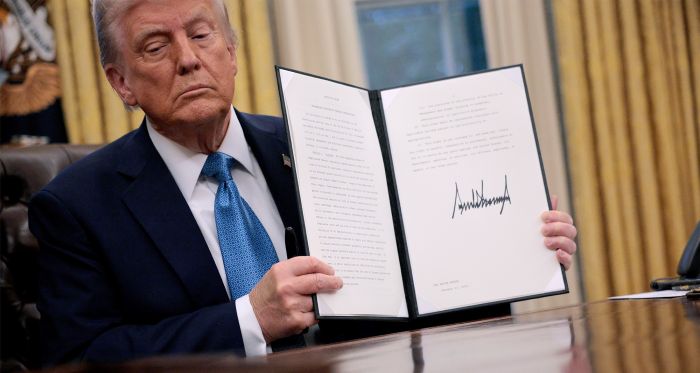On February 1, 2025, Canada found itself on the brink of a devastating trade war with the United States. As is always the case, the spectre of war began with a larger country attacking its smaller neighbours, listing a string of grievances – its ‘casus belli,’ or cause for war. As always, the casus belli was false. They always are. Wars are predatory, and the prey is the object, not the cause of the attack. While U.S. President Donald Trump announced a 30-day pause in tariffs against Canada (and Mexico, but not China) on February 3, existential uncertainty still hangs over the Canadian economy. Let’s deconstruct President Trump’s case for war and see where that takes us.
Trump’s 'casus belli'
The White House fact sheet justifying the Executive Order that has threatened a trade war on Canada states that “The extraordinary threat posed by illegal aliens and drugs, including deadly fentanyl, constitutes a national emergency under the International Emergency Economic Powers Act (IEEPA).”
However, that Order then incongruously adds “. . . in 2023 the U.S. trade deficit in goods was the world’s largest at over $1 trillion,” and goes on to praise the efficacy of tariffs. These are constant themes with President Trump – who bitterly complains about the Canadian contribution to this trade deficit – but have nothing to do with the stated ‘emergency.’
The fact sheet further asserts, "When voters overwhelmingly elected Donald J. Trump as President, they gave him a mandate to seal the border. That is exactly what he is doing.”
The emergency
The United States does have a health crisis related to the use of opioids – as does Canada (with almost 50,000 deaths due to opioid overdose since 2016). Where did this come from? It came from the United States and began with the widespread abuse of OxyContin that opened the door to the more recent scourge of fentanyl, another highly addictive opioid. As the U.S. General Accounting Office (GAO) stated in a 2003 report, “. . . the Food and Drug Administration (FDA) approved Purdue Pharma’s controlled-release pain reliever OxyContin in 1995. Sales grew rapidly, and, by 2001, OxyContin had become the most prescribed brand-name narcotic medication for treating moderate-to-severe pain . . . by 2003 nearly half of all OxyContin prescribers were primary care physicians.”
Were U.S. authorities aware that this was a problem? Absolutely. The GAO report notes:
- “. . . the active ingredient in OxyContin is twice as potent as morphine, which may have made it an attractive target for misuse.”
- “. . . the original label’s safety warning advising patients not to crush the tablets because of the possible rapid release of a potentially toxic amount of oxycodone may have inadvertently alerted abusers to methods for abuse.”
- “. . . the significant increase in OxyContin’s availability in the marketplace may have increased opportunities to obtain the drug illicitly.”
The U.S. Drug Enforcement Agency (DEA) was aware of the problem, as it “. . . expressed concern that Purdue’s aggressive marketing of OxyContin focused on promoting the drug to treat a wide range of conditions to physicians who may not have been adequately trained in pain management.”
The FDA, which had approved the drug because it believed that the controlled-release formulation of OxyContin would result in less abuse potential, since the drug would be absorbed slowly and there would not be an immediate “rush” or high that would promote abuse, slapped Perdue on the wrist for violation of regulations related to marketing.
Thus, with the approval and inaction of the U.S. authorities, the United States created widespread addiction to a powerful opioid, paving the way for similar drugs, including fentanyl. It was big business and highly profitable. Eventually, the United States prosecuted the parent company of Purdue Pharma for misbranding OxyContin and suggesting it was less addictive and more suitable for general use than it actually was, although the authorities had approved it precisely on the grounds of its belief that this was the case.
The U.S. emergency is a crisis of demand, not supply. It is homegrown – made in the United States. It was enabled by profound mistakes of judgement and even greater negligence on the part of U.S. authorities.
Canada’s crisis is also homegrown. Health Canada approved Oxycontin for use in Canada in 1996, a year after the FDA approved it. Was there due diligence on the part of Canadian authorities? Not according to this recent retrospective assessment of Purdue Pharma's submission to Health Canada:
“None of the trials sponsored by Purdue Pharma sought to meaningfully assess the risks of misuse or addiction associated with OxyContin. The trials were short in duration (maximum length was 24 days) and only assessed the safety and efficacy of a 12-h[our] dosing interval. Also, the two trial reports that explicitly mentioned (but did not formally evaluate) the risk of misuse were not published, making it unclear how Health Canada concluded that there was no risk of misuse.”
If Canada were to follow suit and blame foreigners for our mistakes, Canada would have a legitimate case to impose massive tariffs on U.S. exports in response to our opioid crisis. But our crisis is our fault, just as the U.S. is theirs.
The border
The United States is very particular about its border, as is evident from a widely reported incident some years ago. The case involved a 19-year-old girl from France visiting her mother in B.C. and straying a few metres over the unmarked border while jogging on the beach. She was arrested by attentive U.S. border officers, taken to a private for-profit detention centre 226 kilometres away from the border, and held for 15 days behind barbed wire with 100 others.
The United States has a Border Service that is solely responsible for who and what enters the United States. It is located on the U.S. side of the border, and it is big and profitable business to detain anyone who strays so much as a foot over the border.
Canada has a border service as well. It is located on the Canadian side of the border and is solely responsible for who and what enters Canada. That’s how borders work. Canada does not delegate its sovereign decision on who and what enters Canada to the United States, and the same goes for the U.S.
Illicit cross-border traffic
Canada has one of the strictest regulatory regimes for chemicals in the world and, for a long time, has been fighting the importation of fentanyl, which largely came into the country in small, almost undetectable amounts – and as chemical precursors to the opioid – through the mail. In recent years, domestic supply has increased, given Canada’s own crisis, but remains largely a system of atomized producers serving the domestic market.
Meanwhile, the United States, the epicentre of the fentanyl crisis, has one of the laxest chemical regulatory regimes and has weakened its internal systems rather than strengthened them. A 2019 Rand study observed that “improving surveillance and monitoring is crucial.” A 2024 Brookings study commented on the lack of action as follows:
“Drug enforcement is about market regulation, yet the federal government makes little effort to collect systematic market data. Restoring researcher access to the System to Retrieve Information from Drug Evidence (STRIDE), the Drug Enforcement Agency’s data system for drug price and purity, is an easy first step. Other relatively easy steps are to strengthen the National Forensic Lab Information System (NFLIS), a national seizure database, and reestablish drug abuse monitoring programs among justice-involved populations, as well as the adoption of wastewater drug monitoring.”
The replacement of plant-based opioids like heroin and cocaine with synthetics like OxyContin and fentanyl has not only made the substances deadlier but also harder to restrict due to low cost, low detectability, and the wide array of substitute precursor chemicals for production. This emphasizes the inherent difficulty of tackling a demand-side problem with supply-side approaches.
Which brings us to interdiction at the border. As the New York Times reported, “Last year [2024], U.S. Customs and Border Protection agents intercepted about 19 kilograms of fentanyl at the northern border, compared with almost 9,600 kilograms at the border with Mexico.” The supply from Canada represents 0.2 per cent of the known cross-border supply into the United States. That is on a gross flow basis, however. The net flow is actually negative, according to a March 5, 2025, Brookings' report that noted: "In 2023, the U.S. Customs and Border Protection Agency seized only 43 pounds of fentanyl coming from Canada to the United States … while it seized 882 pounds heading from the United States to Canada."
Meanwhile, regarding the flow of migrants, there are three important observations:
- First, according to data from U.S. Customs and Border Protection, in fiscal year 2024, 198,929 people were stopped at the U.S.-Canada border: “These encounters typically involve those who either do not have the proper documentation to enter the U.S. or are seeking asylum.” In other words, these are people who present themselves to U.S. authorities, seeking to enter the United States legally but fail. This figure is often cited as “illegal immigration,” but it is actually “failed legal immigration.”
- Second, actual illegal immigration – i.e. persons who successfully enter between ports of entry – is unknown (for obvious reasons), but the ratio of persons arrested to those who are “encountered” is very small. In B.C., for example, a CBC report indicates 1,662 arrests but 42,913 “encounters” in 2023 based on U.S. border services data, or only 3.9 per cent of the total. Accordingly, the use of the total “encounters” to sensationalize “illegal immigration” amounts to ‘Trumpaganda.’
- Third, there is a counterflow from the United States into Canada, meaning the net flow into the United States is even smaller than the minuscule gross flow.
In short, there is no meaningful “crisis” on the Canada-U.S. border, either in illegal migration or fentanyl traffic. Moreover, officials on both sides of the border are aware of the human trafficking scams and respond in the normal course – without the application of punitive tariffs.
In every sphere of human activity – whether it be white collar crime, corruption, illicit financial flows, drug trafficking, etc. – a Price Waterhouse survey concluded the costs, although hard to measure, were below five per cent of GDP and typically in the 1-3 per cent range. Shoplifting, employee theft, and vendor malfeasance, which are well documented because of estimates of “shrinkage” of retail inventory compared to sales, constitute about 1.6 per cent of the total turnover. This is a “cost of business” – and there is all the difference in the world between a cost of business and a “crisis.” This is not to dismiss the need for efforts to keep the cost down – these costs are below 5 per cent precisely because of efforts by business and government to stop malfeasance.
What’s trade got to do with it?
The claims of an alleged “crisis” on the Canada-U.S. border related to flows of fentanyl and illegal immigration, on which the punitive tariffs announced by the Trump administration on February 1, 2025, were based, are specious. By extension, the deal that was struck to forestall their implementation is performative.
Moreover, the tariffs would be damaging economically as well as being ineffectual as regards the ostensible objectives if imposed in the future. This conclusion has been reached by the Wall Street Journal’s Editorial Board, which called imposing tariffs on Canada and Mexico “The Dumbest Trade War in History,” and by the U.S. Chamber of Commerce, which commented as follows: “. . . the imposition of tariffs under IEEPA is unprecedented, won’t solve these problems, and will only raise prices for American families and upend supply chains.” Meanwhile, the blogosphere has erupted with analyses supporting similar conclusions. And here, it must be emphasized that any comment that applies to Canada and Mexico combined applies many times over more emphatically to Canada alone.
But trade will suffer if there is no effective pushback from the U.S. legal system and American institutional interests (including both trading companies and U.S. states, which depend on commerce with their neighbours) and if U.S. tariffs, and countermeasures by Canada and Mexico, are put in place for any extended period of time. Indeed, a good part of the damage has already been done in terms of undermining confidence in the North American economy.
The implementation of outsized trade tariffs is also consistent with the rise of populist trade economics, which has captured the Trump Administration and embraces a narrative that globalization has done the U.S. wrong, caused its de-industrialization, and is the prime source of all the country’s social ills, including the deaths and despair of the fentanyl crisis. Even without considering the still more ominous overtones of economic coercion to enable an outright annexation of Canada, if the U.S. follows through with its tariff threats, Canada may have to learn to survive and thrive in a very different world than the one it has grown accustomed to.
Donald Trump has put forward a casus belli in his Executive Order imposing tariffs on Canada and Mexico. This case is false as such cases typically are – Paul Krugman has compared fentanyl in this case to the non-existent weapons of mass destruction that were invoked to justify another war of a major power on a minor power – the U.S.-led invasion of Iraq in 2003. And if history is any guide, the consequences of the ‘America First’ trade policy will not be those anticipated by that policy.





